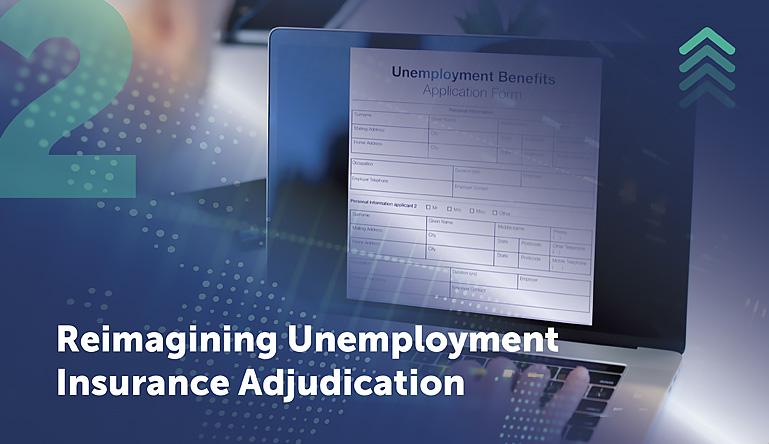-
 Sr. Software Implementation Manager, Catalis Regulatory & Compliance
Sr. Software Implementation Manager, Catalis Regulatory & ComplianceWith 25+ years of experience, he leads collaborative software implementations that modernize state workforce agencies.
View all posts
The Future of UI Casework
This is post two of our five-part series on the future of Unemployment Insurance (UI) adjudication and modernization.
In Part 1 of this series, we explored the crisis in UI adjudication: systems that buckle under surges, pandemic backlogs that left millions waiting for benefits, fraud schemes that drained billions, and inequities that hit low-income and non-English-speaking claimants hardest. In Part 2, we turn to one of the most promising answers: Intelligent Fact-Finding (IFF).
IFF is not a simple tweak to legacy unemployment insurance software for government. It is a wholesale reimagining of how evidence is collected, shared, and acted upon during adjudication. By moving from fragmented, siloed workflows to centralized, automated, and transparent casework, IFF lays the foundation for a modernized UI benefits administration system that is faster, fairer, and more resilient.
From Silos to Integration
For decades, state UI agencies have relied on disconnected systems or manual processes to adjudicate claims. Employers submit wage and separation data through one portal, claimants provide documents through another, and caseworkers toggle between outdated databases to reconcile the two. Each step adds friction. Each handoff creates delays. And each gap in communication introduces opportunities for mistakes and inequities.
An end-to-end unemployment insurance solution for states must break these silos. Intelligent Fact-Finding does exactly that. By consolidating employer responses, claimant evidence, and third-party data into a single record, IFF ensures caseworkers can make determinations based on complete, consistent information.
Think of it as moving from patchwork casework to an adjudication case management system for unemployment insurance designed to streamline every step. Instead of juggling multiple logins, spreadsheets, and faxed employer forms, caseworkers access one transparent file. Claimants and employers benefit too, because they no longer face redundant requests for the same paperwork.
How IFF Works in Practice
Imagine a claimant flagged for potential ineligibility. In traditional systems, that person might receive multiple notices, one from the state asking for wage stubs, another from an employer portal requesting verification, and yet another from the appeals unit if the determination is challenged. Confusion mounts. Deadlines are missed. Cases drag on.
With IFF, documentation is uploaded once through an automated fact-finding and document upload portal for UI. That evidence is automatically integrated into adjudication workflows and preserved for appeals if needed. Employers respond in the same manner. Caseworkers see everything in one dashboard. And claimants receive clear updates through unemployment insurance software with IVR and chatbot support, which can be delivered in multiple languages.
This shift doesn’t just save time; it reduces inequities. Vulnerable claimants who lack the bandwidth to resubmit forms or track down multiple notices benefit most from simplified, centralized workflows.
Automation and AI in IFF
IFF is also a natural place to introduce responsible automation. For example, an AI-powered unemployment claims adjudication software system can scan submitted documents, categorize them, and flag missing evidence. Caseworkers no longer need to manually sift through dozens of attachments; they see a clean, organized file.
Fraud detection is also strengthened. When evidence is centralized, fraud prevention tools for unemployment insurance can cross-check data in real time. Paired with an identity verification system for UI claims, this prevents fraudulent filings from progressing while minimizing disruption for legitimate claimants.
To build trust, these systems must be AI-neutral unemployment claims processing software. Algorithms must avoid bias, use unbiased AI adjudication tools for UI benefits, and present outcomes through a transparent and explainable UI decisioning system. In practice, that means caseworkers see why a claim was flagged, claimants receive plain-language explanations of decisions, and auditors have full access to logs through a federally compliant AI UI solution with audit logs.
Federal Priorities, State Realities
The U.S. Department of Labor has consistently signaled that modernization is a priority. It aligns with broader federal goals of transparency, accountability, and claimant equity. In fact, pilot programs across several states have shown how equitable adjudication reduces delays, improves claimant satisfaction, and strengthens fraud prevention.
But here’s the reality: with ARPA UI modernization grants rescinded, states cannot wait for new federal funds to underwrite the transition. ROI must come from creative strategies:
- State-funded modernization: legislatures appropriating dollars to replace or enhance legacy unemployment benefits processing systems.
- Multi-state consortia: states pooling resources to build shared state unemployment insurance platforms.
- Public-private partnerships: vendors financing deployment of a scalable cloud-native UI platform built for federal standards, with costs spread over time.
These options are less straightforward than a one-time federal infusion, but they may prove more sustainable. States that invest in IFF now position themselves for long-term savings, especially as fraud losses decline and staff efficiency improves.
The ROI of IFF
What does ROI look like? At the frontline, staff spend less time chasing missing documents. Hours are freed up for higher-value adjudication. That means backlogs shrink, claimants get determinations faster, and call center volumes drop as confusion decreases.
For claimants, ROI is measured in stability: faster benefits, fewer appeals, and clearer communication. For states, ROI includes quantifiable savings, and fraud prevention is one. With IFF tied to identity verification and cross-checks, fraudulent claims are stopped earlier, reducing overpayments and the need for UI overpayment and recovery tracking software later. Appeals are another. With better-documented determinations, fewer claimants file disputes. And those who do find that unemployment appeals and hearings management software integrated with IFF resolves them faster.
ROI also extends to compliance. A federal UI reporting and compliance solution tied to IFF ensures that states can meet evolving federal requirements without costly manual reporting.
The Equity Imperative
IFF isn’t just about efficiency and savings; it’s about fairness. Fragmented systems disproportionately disadvantage the very people UI programs are meant to protect: low-income workers, people with limited English proficiency, and those with inconsistent internet access.
By consolidating processes into one workflow, delivering multilingual support through IVR and chatbots, and presenting decisions transparently, IFF makes UI adjudication more equitable. It transforms the unemployment insurance experience from a bureaucratic maze into a clear, navigable process.
Conclusion
Intelligent Fact-Finding is more than a technical upgrade. It is a paradigm shift in how UI casework functions. By centralizing evidence intake, automating workflows, and embedding transparency, IFF addresses the very bottlenecks that created the crisis exposed during the pandemic.
States that adopt IFF as part of a modernized UI benefits administration system will see fewer backlogs, stronger fraud prevention, improved compliance, and fairer outcomes for claimants. Those who delay risk repeating the failures of the past.
Catalis UI solutions are built with intelligent fact-finding at the core: centralizing evidence intake, automating workflows, and helping states deliver faster, more equitable determinations.
Curious how IFF could transform your casework? Reach out to Catalis for a walkthrough of our platform and see how centralized workflows can cut delays and improve claimant trust.
Visit Catalis for a comprehensive look at our solutions for government and the public sector.


